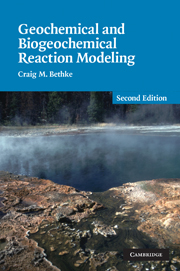Book contents
- Frontmatter
- Contents
- Preface
- Preface to first edition
- A note about software
- 1 Introduction
- 2 Modeling overview
- Part I Equilibrium in natural waters
- Part II Reaction processes
- Part III Applied reaction modeling
- 22 Hydrothermal fluids
- 23 Geothermometry
- 24 Evaporation
- 25 Sediment diagenesis
- 26 Kinetics of water–rock interaction
- 27 Weathering
- 28 Oxidation and reduction
- 29 Waste injection wells
- 30 Petroleum reservoirs
- 31 Acid drainage
- 32 Contamination and remediation
- 33 Microbial communities
- Appendix 1 Sources of modeling software
- Appendix 2 Evaluating the HMW activity model
- Appendix 3 Minerals in the LLNL database
- Appendix 4 Nonlinear rate laws
- References
- Index
29 - Waste injection wells
Published online by Cambridge University Press: 05 August 2012
- Frontmatter
- Contents
- Preface
- Preface to first edition
- A note about software
- 1 Introduction
- 2 Modeling overview
- Part I Equilibrium in natural waters
- Part II Reaction processes
- Part III Applied reaction modeling
- 22 Hydrothermal fluids
- 23 Geothermometry
- 24 Evaporation
- 25 Sediment diagenesis
- 26 Kinetics of water–rock interaction
- 27 Weathering
- 28 Oxidation and reduction
- 29 Waste injection wells
- 30 Petroleum reservoirs
- 31 Acid drainage
- 32 Contamination and remediation
- 33 Microbial communities
- Appendix 1 Sources of modeling software
- Appendix 2 Evaluating the HMW activity model
- Appendix 3 Minerals in the LLNL database
- Appendix 4 Nonlinear rate laws
- References
- Index
Summary
Increasingly since the 1930s, various industries around the world that generate large volumes of liquid byproducts have disposed of their wastes by injecting them into the subsurface of sedimentary basins. In the United States, according to a 1985 survey by Brower et al. (1989), 411 “Class I” wells were licensed to inject hazardous and nonhazardous waste into deep strata, and 48 more were proposed or under construction. Legal restrictions on the practice vary geographically, as does the suitability of geologic conditions. Nonetheless, the practice of deep-well injection had increased over time, partly in response to environmental laws that emphasize protection of surface water and shallow groundwater. More restrictive regulations introduced in the late 1980s and 1990s have begun to cause a decrease in the number of operating Class I wells.
Some injected wastes are persistent health hazards that need to be isolated from the biosphere indefinitely. For this reason, and because of the environmental and operational problems posed by loss of permeability or formation caving, well operators seek to avoid deterioration of the formation accepting the wastes and its confining layers. When wastes are injected, they are commonly far from chemical equilibrium with the minerals in the formation and, therefore, can be expected to react extensively with them (Boulding, 1990). The potential for subsurface damage by chemical reaction, nonetheless, has seldom been considered in the design of injection wells.
According to Brower et al. (1989; Fig. 29.1), nine wells at seven industrial sites throughout the state of Illinois were in use in the late 1980s for injecting industrial wastes into deeply buried formations; these wells accepted about 300 million gallons of liquid wastes per year.
- Type
- Chapter
- Information
- Geochemical and Biogeochemical Reaction Modeling , pp. 427 - 434Publisher: Cambridge University PressPrint publication year: 2007



